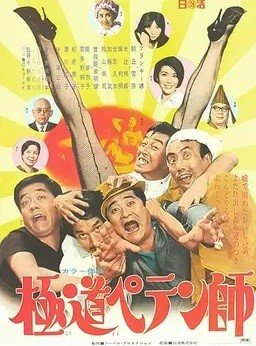The year is 1969. Fabulous Swindler Kampai (Frankie Sakai) circles a small airplane high above the Osaka waterfront, ranting and raving. There will be more scams, there will be better scams, there will be the greatest of scams, he promises himself while throwing thick wads of cash out of the window.
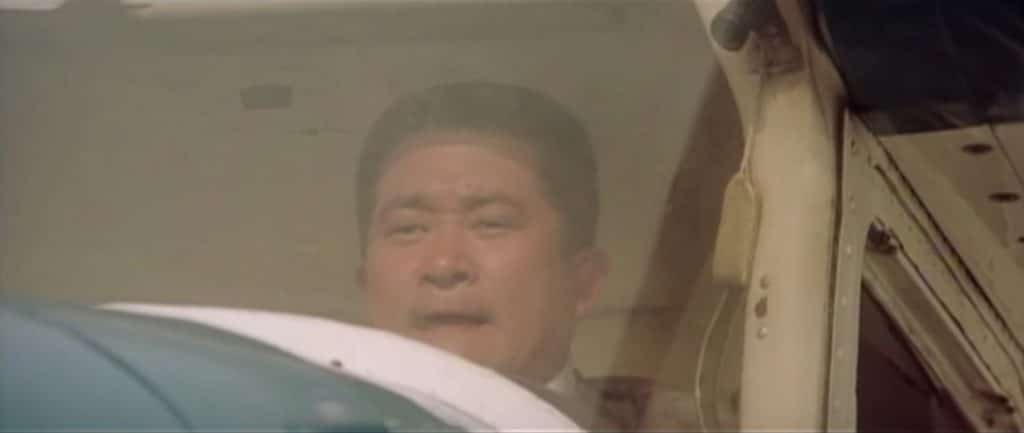
Keeping his loot for long has never been his style. Kampai likes to make his money quick – and he likes to spend it just as quickly. This time literally throwing it out the window… just because he feels like it.
Now, this is almost the final scene of Gokudo Petenshi, to give the Japanese title of the movie. It could however just as well be the opening scene. In fact, the movie trailer does start out with this scene.
Gokudo Petenshi, a raunchy crime comedy, starts out with a different sort of aircraft over central Osaka: American bombers dropping their deadly load on the city in the final days of World War II. It’s black & white archival footage, immediately followed by footage of General Douglas MacArthur stepping out of a plane upon the surrender of Japan, footage of black markets and begging children.
An off-screen voice informs the viewer that those days are long gone. The images change to color and aerial views of large modern housing projects appear, images of business men in suit and tie heading to work, images of newly re-erected Tsutenkaku Tower, the new tower being much taller than the original. (The new Tsutenkaku Tower opened in 1956 after the original one was destroyed in a fire in 1943).
Osaka, a city in full upswing, the narrator gushes while images of large-scale construction sites come into focus.
There is just that one area that has been left behind in all that modern development, Kamagasaki, close to Tsutenkaku Tower.
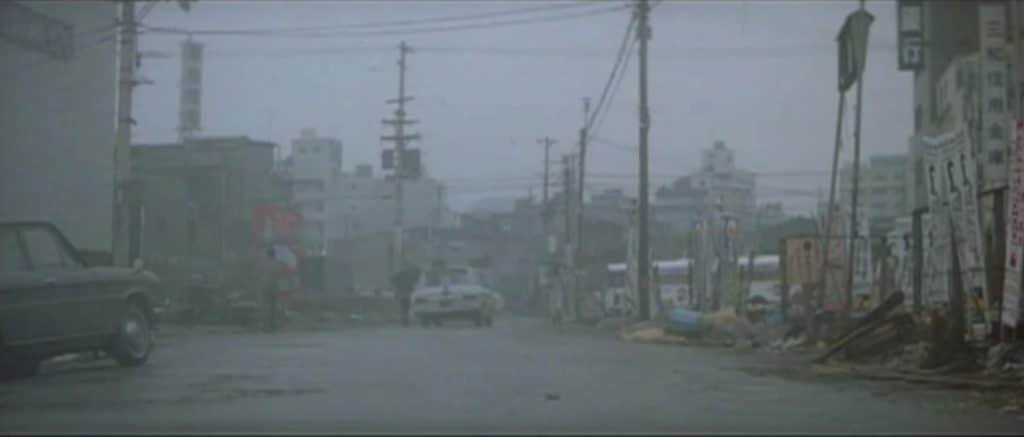
Kamagasaki, a heaven for day laborers, has always been a poor area, notorious for the large number of homeless from all over Japan seeking refuge there.
There are no homeless in sight in Gokudo Petenshi but the area is clearly pointed out as the last true slum of Osaka. A slum so bad that nobody ever cared to remove the unexploded bombs left from the war, still sticking out of the ground.
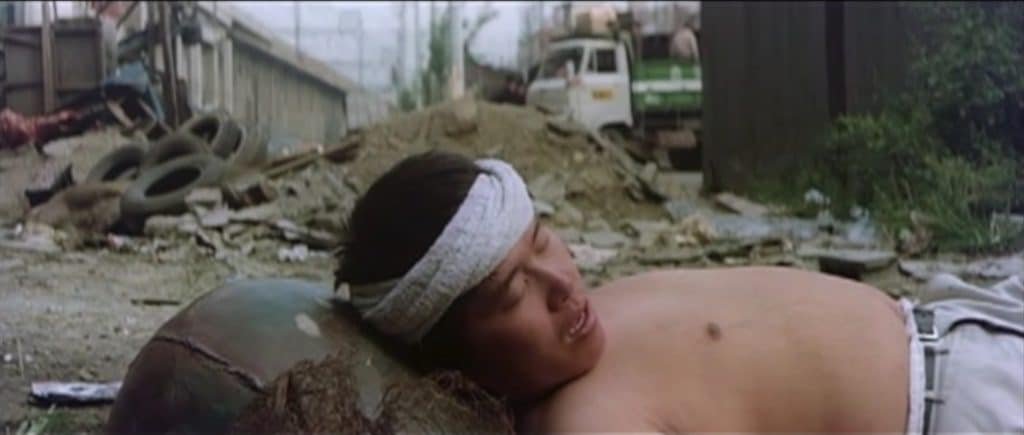
The film focusses on one of those bombs. By 1969, 24 years after the end of the war, the bomb has become a regular feature of the neighborhood. People walk around it with their shopping bags in hand, boys piss on it, drunks use it as a convenient, cool headrest when sleeping on the street.
In short, Kamagasaki is presented as a wild urban area where anything is possible. That’s where Kampai (Frankie Sakai) and his band of Fabulous Swindlers live and thrive.
The places where they spend their money at night, though, tend to be in neighboring Shin Sekai, in the immediate vicinity of Tsutenkaku Tower. That’s where the restaurants are (the Fabulous Swindlers love their yakiniku) and where the strip clubs were in the late 1960s.
Table of Contents
Fabulous Swindlers (Japan 1969) 極道ペテン師
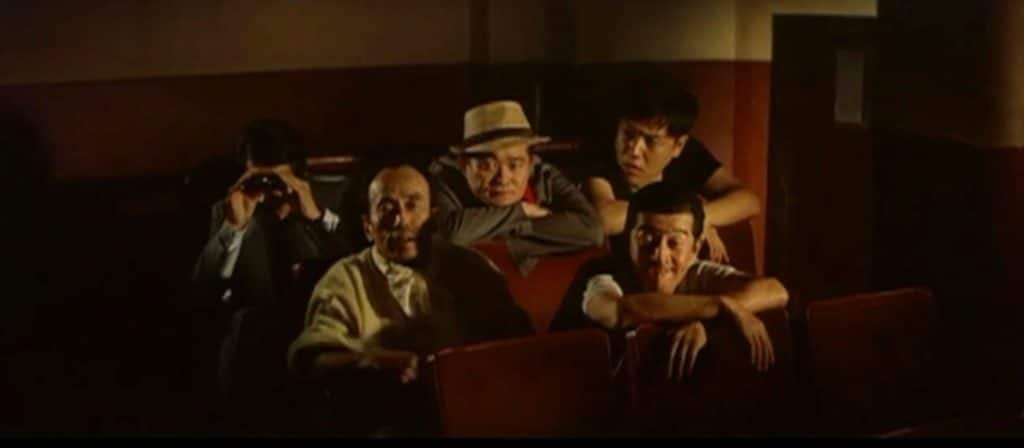
Perhaps, here a little discussion of the film’s title would be appropriate. While the Japanese title Gokudo Petenshi is undisputed, it may very well be that the movie never had any official release outside of the country.
The English-language title Fabulous Swindlers only appears announcing a private upload of the original Japanese-language trailer of the movie on youtube.
Fabulous Swindlers would however make for a great title of the movie in English if any distributor would actually dare to market the film on an international scale.
That title would also be very close to the original meaning of Gokudo Petenshi.
The Plot
The movie zooms in on the Kamagasaki / Shin Sekai area. To a strip club, to be exact. There we witness how Kampai and his small group of dedicated scammers spend the loot of their last exploit. The girls on stage are gorgeous, the champagne flows.
But Kampai always keeps his eyes open for the next victim. The horny, greedy headmaster of a Buddhist temple just outside of Osaka this time.
Kampai and the temple master soon make “friends” and they begin to talk business.
To make a longer story short, the temple master agrees to Kampai’s idea to do a special fundraiser at the temple, introducing a new phallus centric service to the temple, aimed at older ladies who had lost their husbands in the war or live with impotent spouses.
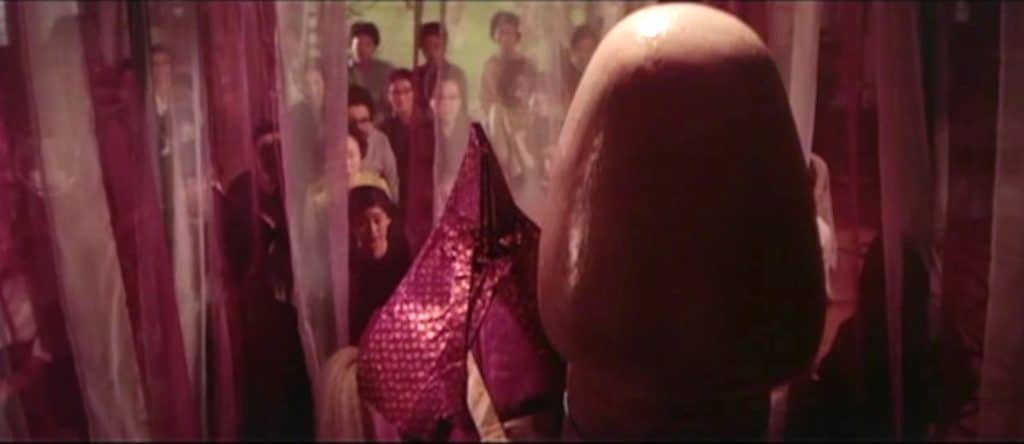
While the worship of phallic sculptures is quite common at some Japanese Shinto shrines, such a worship would be quite unusual for a Buddhist temple.
Still, the greedy temple master goes for it.
Kampai’s scammer group arranges the event perfectly, raking in huge amounts of cash from the sex-starved elder ladies.
At the end of the day, they hand over a big bundle of cash to the temple master, celebrating their success.
“Your temple is so popular now,” they tell the temple master, “You might need a new parking lot. We will build it for you. Could you please sign this blank sheet of your official temple stationary to give us the ability to do so?” The temple master happily does.
In the next scene, we see the temple master crying and hitting his head against a wooden beam in the temple he used to own. Kampai had made good use of the blank paper and sold the whole temple to someone else.
Scenes follow on Kampai and his fellow swindlers spending their gain relaxing at a hot spring resort. Once a group of teenage girls bused in by a Christian missionary school arrives, things get really hilarious. Kampai and his friends have the time of their lives… maybe those scenes got the film the 18+ rating it eventually got.
The Minister of Economics
Scamming the religious is a concept as old as time. Kampai’s next coup was much more ingenious and much more akin to modern times in Japan.
Kampai reads in a newspaper that the Minister of Economics is going to visit the rural production plant of a large electronics manufacturer. Kampai knows that large bribes will be paid at any such visit. In cash and under the table.
By coincidence, Kampai’s local NHK (called MHK in the movie) broadcast fee collector has a striking resemblance to the Minister of Economics. The older gentlemen agrees to go with the scheme.
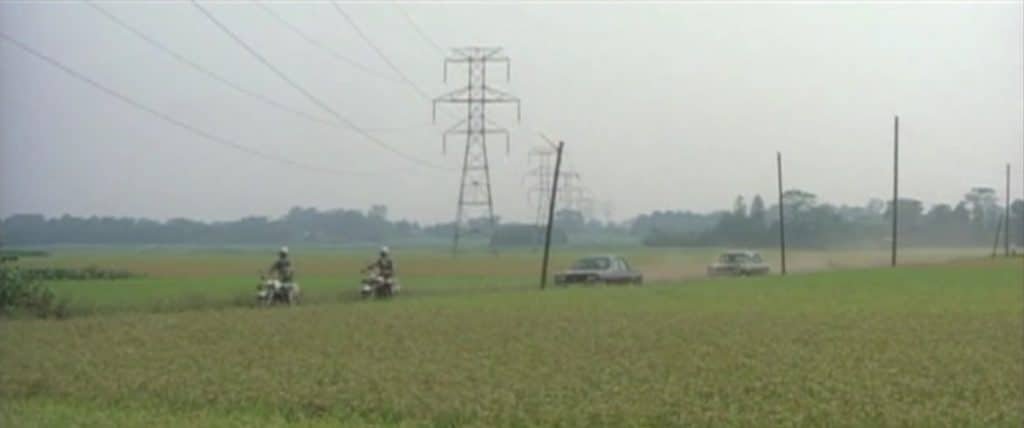
Thus, Kampai arranges a visit to the electronics factories right before the real minister arrives. He arranges for an impressive motorcade traveling to the factory, located out in the rice paddies of Higashiosaka. Changed road signs send the minister in the wrong direction.
The Boy
At about the same time, a young boy (played by Hiromi Ninomiya), about age 8, appears at Kampai’s doorstep. He loudly claims that Kampai is his father.
When Kampai’s associates watch a blue movie (illegal porn), the boy suddenly shows up and claims that the woman in the picture is his mother.
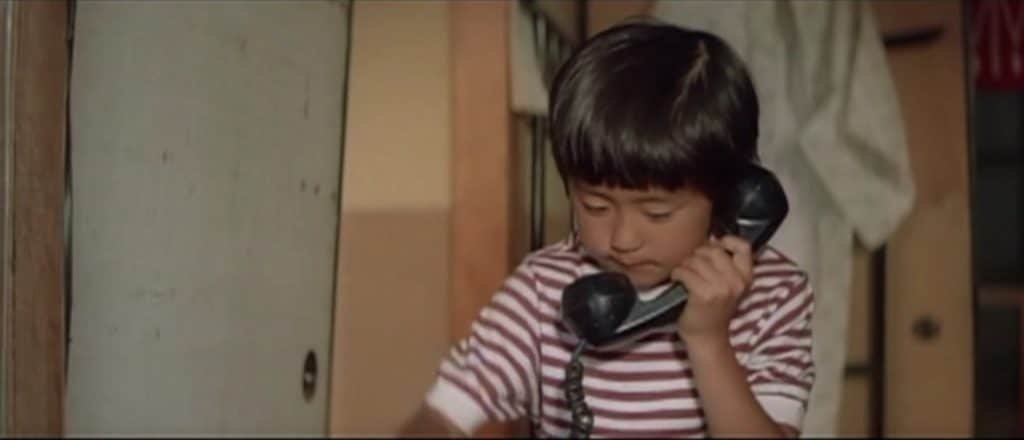
None of it proves to be true. Kampai is not the father, the porn actress not his mother. But who is the boy? He always shows up in the most inconvenient moments, he is irrepressible. Kampai’s sometimes radical attempts to get rid of the boy yield no results… he is always back.
Things take a rather dramatic turn soon after and yes, that bomb stuck in the ground in Kamagasaki does eventually explode.
Frankie Sakai
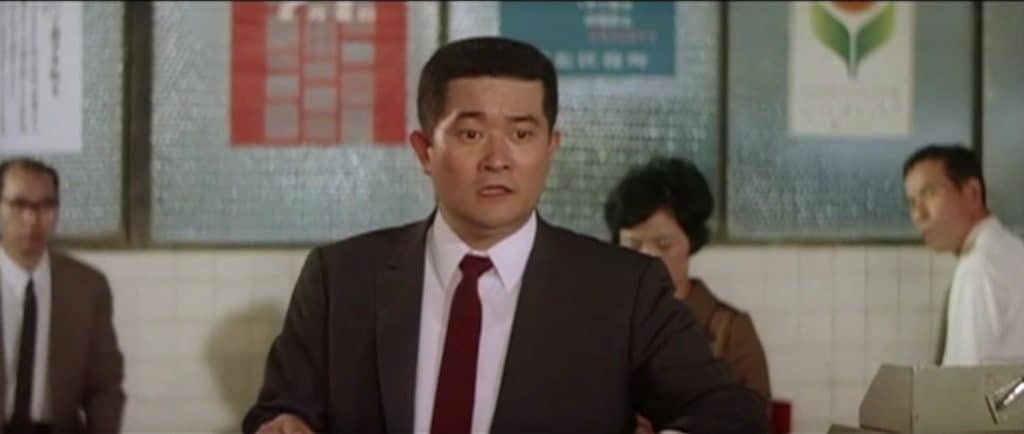
Frankie Sakai (1929 – 1996) was originally born Masatoshi Sakai. He acquired his English-sounding name when working as jazz drummer at American Army clubs in the post-war era. He often performed comedic scenes in addition to his musical performances and eventually became a full-blown comedian, acting in a large number of Japanese comedy movies. Sakai did however also serious acting in a wide array of genres including kaiju monster films (Mothra, 1961), gangster flicks and jidaigeki period dramas. According to a list on the Internet Movie Data base (IMDb), Sakai acted in 173 films in the course of his career.
Sakai had a very strong screen presence, displaying a wide range of acting skills. It’s Sakai who makes Gokudo Petenshi the weirdly funny film it is.
Meiko Kaji

Meiko Kaji (born in 1947) is the other famous name associated with Gokudo Petenshi. In fact, she played only a very minor role in the movie as stripper and occasional lover of (impotent) Kampai. The character she plays, Akemi, has no impact on the development of the story.
Kaji was at the time of filming however an up-and-coming Nikkatsu movie star. Not famous yet but soon she would be. Thus, the producers made sure, she had a role in the movie.
Indeed, one year later, in 1970, Kaji burst on the scene as the boss of an outlaw biker girl gang in the Alleycat Rock movie series. To avoid being casted in the pink movies (sex movies) Nikkatsu started to produce from 1971 on, Kaji changed to Toei Studio, starring there in the Female Convict Scorpion series before achieving global fame as deadly sword swinging avenger in Lady Snowblood (1973).
Meiko Kaji is also an accomplished singer, most famous for singing the theme songs of both Female Convict Scorpion and Lady Snowblood.
In 2011, Meiko Kaji released a new album with songs written for her by Ryudo Uzaki and his wife Yoko Aki. Ryudo Uzaki, a rock musician and actor, is perhaps best known for his role as bank robber in Tattoo Ari.
The Director: Koji Chino
Koji Chino (1930 – 2022) must have been a difficult person to work with. Already as an assistant director, typically a position where future directors learn their craft, Chino is said to have been such a perfectionist that he arranged everything the way he liked it before the actual director came to the scene, then telling the director, “Now, please start your work.”
Chino directed a few movies for Nikkatsu, including Gokudo Petenshi but got frequently into fights with the producers.
As a result, he became blacklisted by the movie studios. Subsequently, he spent most of his career as director of TV productions.
The Production
Gokudo Petenshi was based on a story written by Akiyuki Nosaka (1930 – 2015), a writer known for plumbing the depths of Osaka for his social commentary. Nosaka, who in 1983 was voted into the Diet, the Japanese parliament, also wrote the book Shohei Imamura’s 1966 Osaka movie The Pornographers was based on.
The production company was Nobel Productions, a newly founded subsidiary of Nikkatsu Studio. As producer served Jiro Tomoda who had also been one of the co-producers of The Pornographers.
Nobel Productions was severely underfunded while director Koji Chino liked to overspend on the budget. This led to several interruptions of the shooting. Unpaid staff refused to continue working while Chino tried to raise additional funds from Nikkatsu.
The shooting took one year, most of it was done at the original settings in the Kamagasaki and Shin Sekai areas of southern Osaka.
Osaka Locations
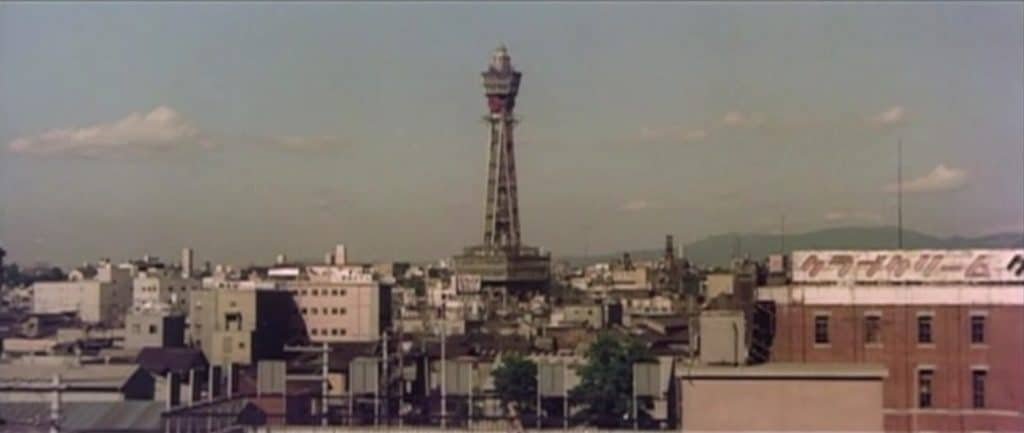
This film is 100% Osaka. Though by 1969 certainly no visible bombs stuck out of the ground in Kamagasaki, all Kamagasaki scenes were shot in Kamagasaki. Kamagasaki lacked clearly identifiable landmarks but the street scenes filmed there do make clear that it was indeed a very poor neighborhood.
Tsutenkaku Tower serves as the great symbol for the re-vitalization of Shin Sekai, the entertainment district located close to Kamagasaki.
At one moment in the movie, Kampai meets up with an ex-girlfriend he hasn’t seen in many years. The meeting takes place on the old Shinsaibashi Bridge in Dotonbori. The bridge, beloved both by the Osaka public and by film directors shooting scenes there, was demolished in 1995.
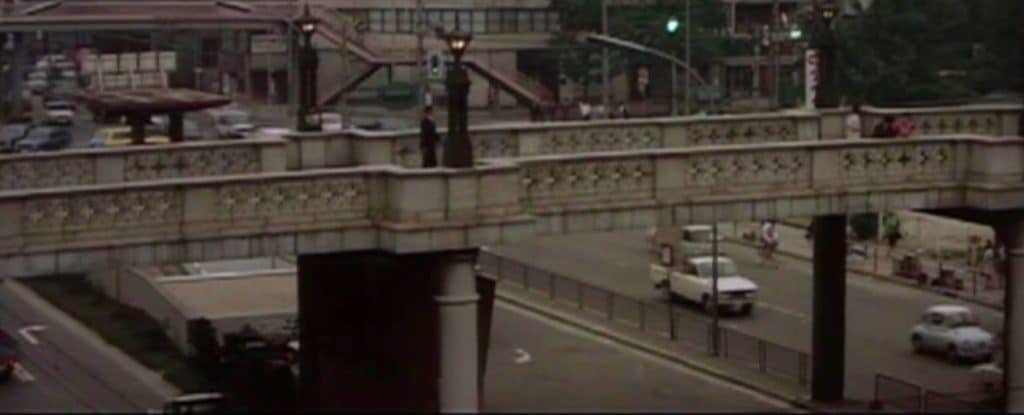
Signs pointing out the production plant of the electronics company scammed off their bribes for the Minister of Economics clearly locate the factory in Higashiosaka, a city in the East of Osaka Prefecture.
The Buddhist temple and the hot spring resort were filmed in a mountainous rural area. Given the financial restrictions of the production, their locations were most likely situated very close to Osaka. Probably in a neighboring prefecture like Hyogo or Nara, places in easy range for Osaka day trippers.
